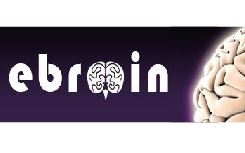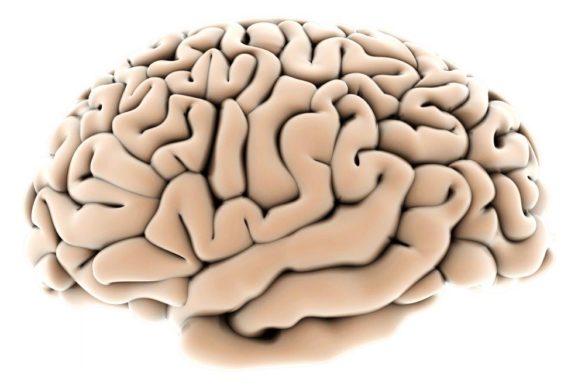A 42-year-old woman came to our observation because of the subacute onset of abnormal movements in the oro-facial region.
Family history was negative for neurological disorders. Her past medical history was remarkable only for spinal surgery (spinal stabilization L4-L5-S1).
At the age of 36, about 6 years before being seen in our Department, she noted the onset of tremor in the right hand. She recalls that the tremor was present mainly in the rest position and that it did not interfere with her activities. Treatment with propranolol 80 mg/day produced only partial improvement and was then withdrawn. About 9 months before our observation, she complained of pain in the temporo-mandibular joint, otalgia and paraesthesias in the left side of the face and of the tongue. Pain and paraesthesias were treated with carbamazepine 400 mg/day without improvement. A few months later involuntary movements affecting the lower part of the face, the mouth, the tongue and the jaw appeared. Neurological examination showed forced dystonia in the oromandibular region in the form of a jaw opening dystonia. Movements were clearly induced or worsened by speaking, eating, and chewing leading to severe impairment in the ability to speak and difficulties in eating. Rest and postural tremor, mild rigidity and bradykinesia (but without faticability in the finger tapping test) of the right upper limb were also present. Brain MRI was normal. Electromyography with polygraphic study showed bilateral tremor at rest in the orbicular muscle of the mouth and in the digastric muscle, and a normal blink reflex recovery cycle. A DAT-SCAN showed normal representation of the presynaptic dopaminergic terminals. Screening for Wilson’s disease and neuroacanthocytosis yielded negative results.
Treatment with dopamine agonists or levodopa (up to a maximal dose of 600 mg/day) did not produce significant improvement in either the focal dystonia or in the rest tremor and mild bradykinesia.
To see the patient, please click here: Grand Rounds_02_2012
Comment by the authors:
This patient presents with asymmetric rest tremor and mild motor impairment of the right hand, which did not worsen along some years of observation, and a subacute onset of oromandibular dystonia. The negative DAT scan in a patient with mild parkinsonian signs is usually classified as a SWEDD scan (scan without evidence of dopaminergic denervation). Several papers have shown that SWEDD has been observed in patients with atypical tremor, mono-symptomatic rest tremor and dystonic tremor. Dystonic tremor has been associated with other focal dystonias, but not with oromandibular dystonia. In conclusion, we think that this patient presents a dystonic tremor of the right hand associated with oromandibular dystonia.
We propose this case to the readers of NEUROPENEWS for comments, description of similar cases, and eventually of successful therapies.
Case presented by:
G. Fabbrini, G. Ferrazzano, M. Bloise, A. Berardelli
Department of Neurology and Psychiatry
University of Rome “Sapienza”, Rome, Italy
Comment by Zvezdan Pirtosek
We read with interest the case report by Fabbrini et al presenting a 42 year female with an asymmetric resting and postural tremor with normal dopamine transporter imaging scan and severe oromandibular dystonia, diagnosed as a case of dystonic tremor. Dystonic tremor remains a poorly classified entity. It is mostly a focal tremor with irregular amplitudes and variable frequency (mostly below 7 Hz), usually not seen during complete rest. More than 20 years ago Rivest & Marsden reported that tremor may appear years before dystonia The MDS Consensus Statement defined “dystonic tremor” as tremor in a body part also affected by dystonia, while “tremor associated with dystonia” refers to tremor in a body part not affected by dystonia, although dystonia is present elsewhere. There are strong views that both of these groups should be called dystonic tremor.
Phenomenologically, tremor in the presented case has many features of parkinsonian tremor (asymmetric, resting tremor unresponsive to propranolol). Furthermore, decreased arm swing (R>L), mild rigidity and bradykinesia of the right upper limb, are also in favour of PD. There are no changes in the wing position (i.e., with the index fingers pointing at each other in front of chin, but preferably without touching or pushing). Unfortunately, it is not entirely clear from the video whether tremor is re-emergent on change in posture, which according to many (e.g. Schwingenschuh) would support diagnosis of parkinsonism (but see de Laat)., On the other hand absent true fatigueability and decrement on finger tapping do not support parkinsonism. Mild motor impairment of the right arm as described above may well be dystonic in nature (dystonic bradykinesia due to co-contraction, impaired muscle tone). There seems to be shoulder asymmetry, possibly dystonic. At this point additional information on impaired postural reflexes, micrographia, impaired olfaction and lack of modifying influence of alcohol may support parkinsonism. It is not clear whether polimyography has been performed on the tremulous right upper limb and what was the pattern of the MUPs (alternate contraction of agonists-antagonists, co-contraction). Tremor in PD usually has a slower frequency of between 3 and 5 Hz, and in dystonic tremor both the frequency and amplitude are often irregular and variable. Unfortunately, patient’s eyes are covered, although eye movements may be give some clues.
Nowadays, such interesting clinical pro and con arguments can be easily solved with the use of dopamine transporter imaging which in the presented patient was normal. With the negative DaT scan early in the workup, this patient thus fell into the SWEDD category. Recent studies suggest that parkinsonian subjects with normal dopaminergic imaging do not have evidence of classical PD or an atypical parkinsonian syndrome. An alternative diagnosis such as essential tremor, vascular parkinsonism, drug-induced parkinsonism, psychogenic parkinsonism or dystonia should be made. Many patients eventually receive a diagnosis of dystonic tremor. Alberto Albanese requests that SWEDD should be labelled as ‘dystonia’ only if clinical signs of dystonia are present and this patient indeed developed oromandibular dystonia a year later. Authors therefore classified this tremor as dystonic.
In the first step, cases of secondary movement disorder were excluded. The course of the disease, lack of other neurological signs, normal MRI and normal screening for Wilson\s disease and neuroacanthocythosis largely exclude secondary movement disorder. The possibility of head trauma, stroke, infections in the brain, drugs or toxins may cause a combination of rest tremor and dystonia and should be actively entertained. Results of thyroid screen would be interesting to know as hyperthyroidism has been associated with tremor and segmental and task-specific dystonia. This improved after treatment with antithyroid medications, with postulated alteration of the dopaminergic system by elevated thyroid hormone.
A point, though not absolute, for the primary cause of dystonia in this patient is its reported action (speech) and movement inducibility. It would be interesting to know if movement disorder persisted during sleep and if sensory tricks (gestes antagonistiques) were absent – both suggestive of secondary dystonia.
Pain in the temporo-mandibular joint, otalgia and paraesthesias in the left side of the face and of the tongue need not be a sign of secondary dystonia – they could also easily be explained with non-motor, sensory component of dystonia. Neurophysiologic and neuroimaging studies have shown a number of sensory abnormalities at cortical and subcortical levels, probably reflecting a dysfunction in the basal ganglia–thalamo-cortical circuits
Authors are right to point out the issue of (often) unsuccessful treatment. I guess treatment with botulinum toxin was eventually initiated. Anticholinergics may improve the dystonic as well as the tremulous component. Clonazepam and baclofen, tetrabenazine, carbamazepine may be tried as well as injecting diluted lidocaine and alcohol intramuscularly. GPi DBS may result in moderate to good response on motor function but marginal benefit on speech.
In conclusion, this is an interesting case which reminds and teaches us of important points: (i) dystonic tremor may occur years before dystonia, (ii) dystonic tremor may occur in parts of the body not (maximally) affected by dystonia (iii) dystonic tremor does not result (only) from a more or less conscious attempt of the patient to restore normal body position against the permanent dystonic muscle contraction; and (iv) oromandibular dystonia is a part of the spectrum of dystonic tremors. It seems to be a rare association, although there are previous reports. Amongst 25 SWEDDs with upper limb rest tremor in Schwingenschuh’s series, there were cases of dystonia with lower face (1), jaw/tongue (1) and larynx (4) distribution, in Schneider’s series 1/10 had involvement of larynx and Case 4 in Schiebler’s series had a mild oromandibular dystonia.
References
Schwingenschuh P, Ruge D, Edwards MJ, Terranova C, Katschnig P, Carrillo F, et al. Adult onset asymmetric upper limb tremor misdiagnosed as Parkinson’s disease: A clinical and electrophysiological study. Mov Disord 2010; 25(5): 560-9.
Schneider SA, Edwards MJ, Mir P, Cordivari C, Hooker J, Dickson J, e tal. Patients with adult-onset dystonic tremor resembling parkinsonian tremor have scans without evidence of dopaminergic deficit (SWEDDs). Mov Disord 2007; 22(15): 2210-5.
Jedynak CP, Bonnet AM, Agid Y. Tremor and idiopathic dystonia. Mov Disord 1991; 6(3): 230-6.
Rivest J, Marsden CD. Trunk and head tremor as isolated manifestations of dystonia. Mov Disord 1990; 5(1): 60-5.
Schiebler S, Schmidt A, Zittel S, Bäumer T, Gerloff C, Klein C, et al. Arm tremor in cervical dystonia – Is it a manifestation of dystonia or essential tremor? Mov Disord 2011; 26(10): 1789-92.
Zvezdan Pirtosek is Professor of Neurology and Head of the Department of Neurological Disorders at the Univesity Medical Centre in Ljubljana, Slovenia.





